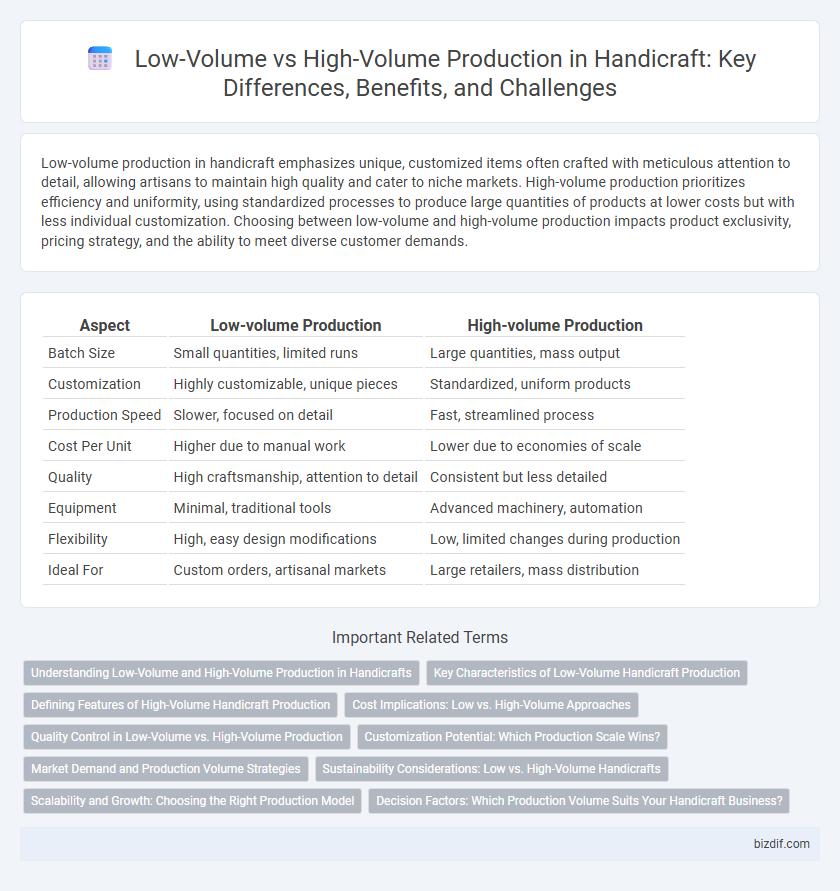Low-volume production in handicraft emphasizes unique, customized items often crafted with meticulous attention to detail, allowing artisans to maintain high quality and cater to niche markets. High-volume production prioritizes efficiency and uniformity, using standardized processes to produce large quantities of products at lower costs but with less individual customization. Choosing between low-volume and high-volume production impacts product exclusivity, pricing strategy, and the ability to meet diverse customer demands.
Table of Comparison
| Aspect | Low-volume Production | High-volume Production |
|---|---|---|
| Batch Size | Small quantities, limited runs | Large quantities, mass output |
| Customization | Highly customizable, unique pieces | Standardized, uniform products |
| Production Speed | Slower, focused on detail | Fast, streamlined process |
| Cost Per Unit | Higher due to manual work | Lower due to economies of scale |
| Quality | High craftsmanship, attention to detail | Consistent but less detailed |
| Equipment | Minimal, traditional tools | Advanced machinery, automation |
| Flexibility | High, easy design modifications | Low, limited changes during production |
| Ideal For | Custom orders, artisanal markets | Large retailers, mass distribution |
Understanding Low-Volume and High-Volume Production in Handicrafts
Low-volume production in handicrafts emphasizes handmade, unique items with careful attention to detail, catering to niche markets and allowing for customization. High-volume production relies on mechanization and standardized processes to produce large quantities of products quickly and cost-effectively, often sacrificing individuality. Understanding the balance between these methods helps artisans optimize efficiency while preserving the authenticity and quality of their crafts.
Key Characteristics of Low-Volume Handicraft Production
Low-volume handicraft production emphasizes artisanal quality, intricate detailing, and customization, resulting in unique, limited-edition products. This approach relies on skilled artisans using traditional techniques, often involving manual tools and slower production cycles. The flexibility in design and production allows for greater creativity, catering to niche markets and preserving cultural heritage.
Defining Features of High-Volume Handicraft Production
High-volume handicraft production is characterized by standardized designs, mechanized tools, and assembly line processes that ensure consistent quality and faster output. It relies on skilled artisans working alongside technology to produce large quantities without compromising intricate details. The emphasis lies on scalability, efficiency, and meeting market demand while preserving traditional craftsmanship elements.
Cost Implications: Low vs. High-Volume Approaches
Low-volume production in handicraft entails higher per-unit costs due to manual labor intensity, specialized materials, and limited economies of scale. In contrast, high-volume production reduces unit costs through mechanization, bulk purchasing, and standardized processes but may compromise the uniqueness and quality of handcrafted items. Balancing cost implications with craftsmanship values is essential for businesses aiming to optimize profitability and product appeal.
Quality Control in Low-Volume vs. High-Volume Production
Low-volume production in handicrafts allows for meticulous quality control, ensuring each piece meets high standards through detailed inspections and handcrafted precision. High-volume production prioritizes speed and efficiency, often relying on automated checks that may overlook subtle defects, sacrificing individual quality for quantity. The controlled environment of low-volume output supports customized craftsmanship, whereas high-volume methods risk consistency issues due to mass manufacturing processes.
Customization Potential: Which Production Scale Wins?
Low-volume production excels in customization potential by offering handcrafted uniqueness and tailored designs that meet specific customer preferences, unlike high-volume production which prioritizes uniformity and cost-efficiency through mass manufacturing. Handicraft artisans can adapt techniques and materials to individual orders, creating personalized products with intricate details impossible in high-volume settings. Customization in low-volume handicraft production drives distinctiveness and superior craftsmanship, establishing it as the preferred scale for unique, bespoke creations.
Market Demand and Production Volume Strategies
Low-volume production in handicrafts caters to niche markets seeking unique, artisanal items with high customization, aligning production strategies with fluctuating and specific market demands. High-volume production targets mass markets requiring standardized products, optimizing economies of scale and consistent output to meet large-scale consumer demand. Balancing these approaches involves analyzing demand trends and adjusting production volume to maximize profitability while maintaining product quality.
Sustainability Considerations: Low vs. High-Volume Handicrafts
Low-volume handicraft production supports sustainability through minimal resource consumption and reduced waste, aligning with eco-friendly practices. High-volume production often demands substantial raw materials and energy, increasing environmental impact despite economies of scale. Artisans prioritizing sustainability typically favor low-volume methods to preserve cultural heritage and promote ethical craftsmanship.
Scalability and Growth: Choosing the Right Production Model
Low-volume production offers flexibility and customization, making it ideal for artisans focusing on unique, handcrafted items with higher profit margins per piece. High-volume production emphasizes scalability, enabling businesses to meet large demand efficiently through standardized processes and reduced per-unit costs. Selecting the right model depends on growth goals, resource availability, and market positioning within the handicraft industry.
Decision Factors: Which Production Volume Suits Your Handicraft Business?
Choosing between low-volume production and high-volume production hinges on factors like market demand, product uniqueness, and resource availability. Low-volume production suits artisans emphasizing quality, customization, and exclusivity, while high-volume production leverages efficiency and cost reduction for mass-market appeal. Evaluating target audience preferences and operational capacity helps determine the optimal production scale for sustainability and growth in the handicraft business.
Low-volume Production vs High-volume Production Infographic

 bizdif.com
bizdif.com